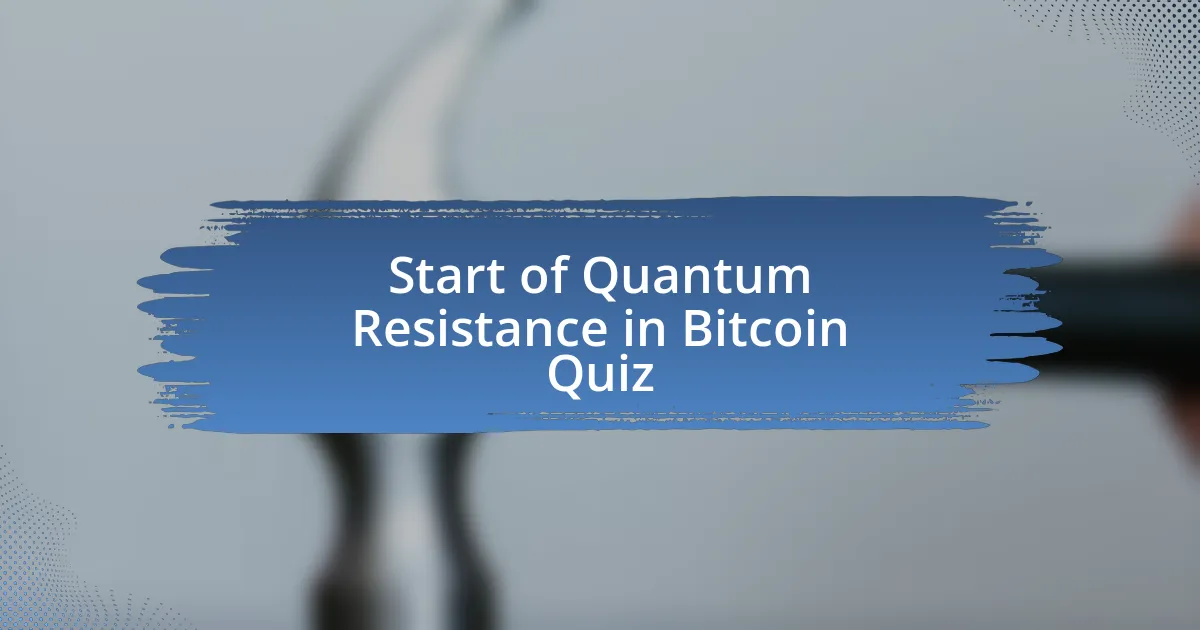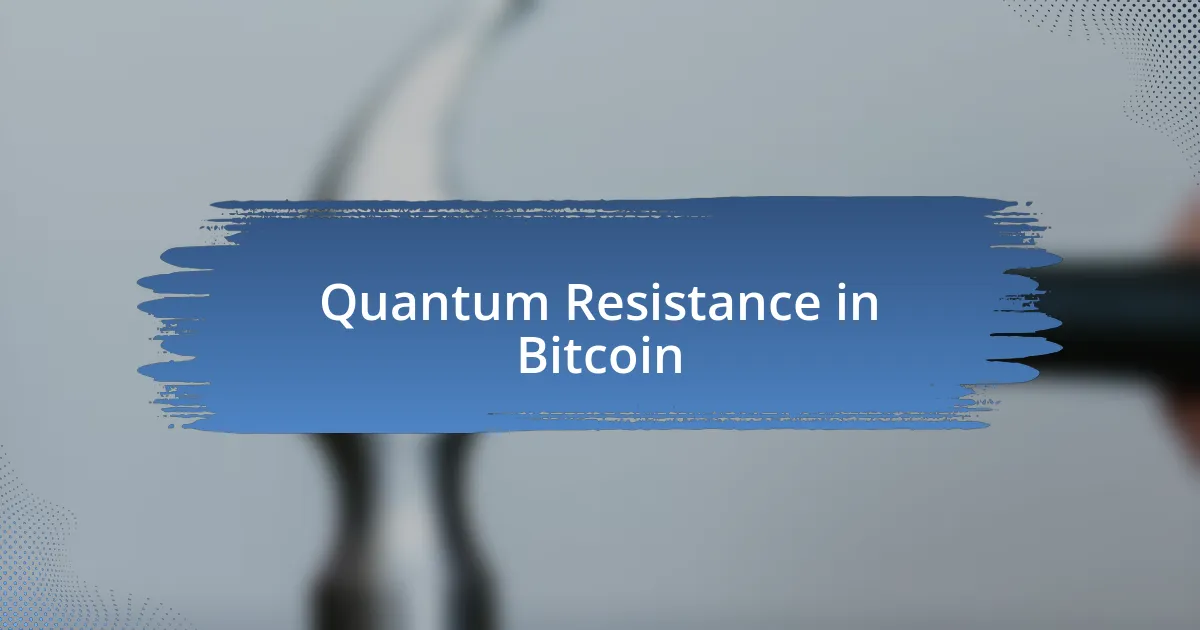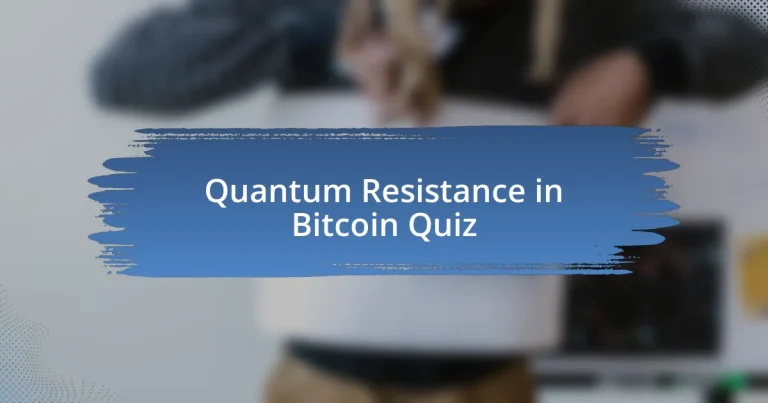
Start of Quantum Resistance in Bitcoin Quiz
1. What is the primary concern regarding quantum computers and Bitcoin?
- Quantum computers will enhance Bitcoin mining efficiency.
- Quantum computers can increase transaction speeds.
- Quantum computers could break ECDSA security.
- Quantum computers can reduce block sizes in Bitcoin.
2. What is the name of the algorithm that could theoretically break ECDSA?
- Grover’s algorithm
- Shor’s algorithm
- Dijkstra’s algorithm
- Prim’s algorithm
3. How does Grover’s algorithm affect the security of SHA256?
- Grover`s algorithm increases the security strength of SHA256 to 512 bits.
- Grover`s algorithm completely breaks SHA256, making it unusable.
- Grover`s algorithm reduces the security strength of SHA256 to its square root, from 256 bits to 128 bits.
- Grover`s algorithm has no effect on the security of SHA256.
4. What is the recommended solution to overcome the reduced security of SHA256?
- Switching to a less secure hashing algorithm for compatibility.
- Using a roughly equivalent algorithm with twice as many security bits, such as going from SHA256 to SHA512.
- Relying on the existing SHA256 without any changes.
- Using the same SHA256 algorithm indefinitely.
5. What is the name of the cryptographic protocol framework used for encrypted communication in LN?
- Signal
- Whisper
- Noise
- Echo
6. How does the use of ECDSA in Bitcoin affect its quantum resistance?
- ECDSA public keys in Bitcoin are susceptible to Shor’s algorithm, making them insecure against quantum attacks.
- ECDSA encrypts transactions so that they are safe from any form of quantum decryption.
- ECDSA uses larger key sizes that are immune to quantum threats, ensuring complete security.
- ECDSA enhances Bitcoin`s quantum resistance, preventing any attacks from quantum computers.
7. What are quantum-resistant alternatives to ECDSA?
- Lamport Signatures
- DSA Signatures
- RSA Signatures
- HMAC Signatures
8. What is the primary advantage of using Lamport Signatures in Bitcoin?
- Lamport Signatures increase transaction fees significantly.
- Lamport Signatures are faster than traditional signatures.
- Lamport Signatures are less secure than ECDSA.
- Lamport Signatures do not require changes to the base layer of Bitcoin.
9. How does the implementation of Lamport Signatures differ from traditional upgrades?
- Lamport Signatures are implemented through a hard fork of Bitcoin.
- Lamport Signatures are coded in smart contracts, avoiding base layer changes.
- Lamport Signatures require a software update to the Bitcoin node.
- Lamport Signatures necessitate a complete overhaul of the Bitcoin network.
10. What is the current status of Bitcoin’s cryptographic system in terms of quantum resistance?
- Bitcoin’s cryptographic system uses outdated technology and is unaffected by quantum attacks.
- Bitcoin’s cryptographic system is currently vulnerable to quantum attacks.
- Bitcoin’s cryptographic system has eliminated vulnerability to quantum threats.
- Bitcoin’s cryptographic system is fully quantum-proof now.
11. What is the estimated time for a quantum computer to break an RSA key?
- Approximately 5 days.
- Approximately 8 hours.
- Approximately 15 minutes.
- Approximately 2 weeks.
12. How long does it currently take for transactions to be mined in the Bitcoin network?
- About 5 minutes, during peak hours.
- About 10 minutes, unless the network is congested.
- About 30 minutes, in all cases.
- About 15 minutes, regardless of traffic.
13. What is the window of opportunity for an attacker to steal coins during a transaction?
- The window of opportunity is from the moment the public key is revealed until the transaction is mined.
- The window of opportunity is while the transaction is pending in the user`s wallet.
- The window of opportunity is from the moment the transaction is initiated until it is confirmed.
- The window of opportunity is from the time the coins are created until they are spent.
14. What happens if a rogue miner attempts to construct an invalid block in the Bitcoin blockchain?
- The invalid block will automatically become the new block in the blockchain.
- The rogue miner`s block will be accepted by the network without any issues.
- Honest miners will ignore the invalid block and build on top of the most recently accepted valid block.
- The rogue miner will receive rewards for the invalid block.
15. How does the distribution of Bitcoins in different address types affect their vulnerability to quantum attacks?
- Coins in p2pk addresses and reused p2pkh addresses are vulnerable to quantum attacks.
- Coins in p2sh addresses are completely immune to quantum attacks.
- All Bitcoin addresses are equally vulnerable to quantum attacks.
- Bitcoin’s cryptographic system is inherently quantum-safe regardless of address types.
16. What is the main assumption about coins in p2pk addresses?
- These coins are held in multi-signature wallets for extra security.
- These coins are only valid for a limited time.
- These coins were generated through mining and have never been moved from their original address.
- These coins can be freely transferred between addresses without restrictions.
17. Can the Bitcoin blockchain be considered quantum-safe if all vulnerable coins are transferred to safe addresses?
- No, because revealing the public key to transfer coins makes the address vulnerable to quantum attacks.
- Yes, if vulnerable coins are moved to cold storage.
- Yes, because all coins would be safe in new addresses.
- No, because addresses can never be made safe from quantum threats.
18. What is the role of miners in the Bitcoin network?
- Miners compete to process transactions and construct new blocks, awarding them new coins.
- Miners are responsible for advertising Bitcoin to attract users.
- Miners validate government transactions using Bitcoin.
- Miners primarily create software updates for the Bitcoin network.
19. How do miners agree on which transactions to include in a block?
- Miners use a random number generator to select transactions.
- Miners vote on transactions using a majority rule.
- Miners wait for a central authority to approve transactions.
- Miners agree by building on top of blocks they agree with, ignoring invalid blocks.
20. What is the purpose of the Proof-of-Work (PoW) system in Bitcoin?
- The PoW system provides an intentionally strenuous computational task to deter malicious attacks.
- The PoW system helps to centralize control over the Bitcoin network.
- The PoW system ensures quick transaction processing by increasing miner rewards.
- The PoW system is designed to simplify the transaction verification process for users.
21. How does the PoW system’s security strength change under quantum computing?
- The PoW system will be completely broken by quantum computers.
- The PoW system will become totally obsolete due to quantum computing.
- The PoW system’s security strength remains robust but could be marginally undermined by quantum computers.
- The PoW system will be entirely unaffected by quantum computing advancements.
22. What is the significance of post-quantum cryptography in securing Bitcoin?
- Post-quantum cryptography simplifies Bitcoin`s encryption methods.
- Post-quantum cryptography enhances Bitcoin`s security against quantum attacks.
- Post-quantum cryptography increases Bitcoin`s transaction speed.
- Post-quantum cryptography has no effect on Bitcoin`s security.
23. What are some post-quantum algorithms being investigated for use in Bitcoin?
- SHA-256
- AES-256
- RSA-2048
- ML-DSA-44
24. How do post-quantum algorithms improve Bitcoin’s security against quantum attacks?
- Post-quantum algorithms reduce transaction times by optimizing block verification processes.
- Post-quantum algorithms encrypt transactions to prevent quantum computers from deciphering transaction values.
- Post-quantum algorithms modify the Bitcoin supply cap to limit inflation during quantum attacks.
- Post-quantum algorithms create significantly more complex problems for a quantum computer to decode, thereby enhancing Bitcoin’s security.
25. What is the current status of research into post-quantum cryptography for Bitcoin?
- Research into post-quantum cryptography has been completed and is fully implemented.
- Research into post-quantum cryptography has been abandoned due to lack of interest.
- Research into post-quantum cryptography is ongoing, with various algorithms being tested.
- Research into post-quantum cryptography has slowed to a halt as no viable solutions exist.
26. What is the impact of using larger key and signature sizes in post-quantum cryptography?
- Increases complexity, enhancing security but may reduce usability.
- Maintains the same complexity and usability as before.
- Decreases security and usability without any complexity change.
- Makes cryptography faster while simplifying usability issues.
27. How does the implementation of post-quantum cryptography affect the usability of blockchains?
- Post-quantum cryptography has no effect on usability at all.
- Post-quantum cryptography enhances usability without any trade-offs.
- Post-quantum cryptography may reduce usability due to larger keys and signatures.
- Post-quantum cryptography makes blockchains completely unusable.
28. What is the role of NIST in evaluating post-quantum cryptography algorithms?
- NIST evaluates post-quantum cryptography algorithms based on their security levels and performance metrics.
- NIST only certifies existing cryptographic standards without evaluation.
- NIST develops proprietary algorithms for national security applications.
- NIST conducts marketing campaigns for quantum computing companies.
29. What are the NIST levels for some post-quantum cryptography algorithms?
- ML-DSA-44 is at NIST level 2.
- Falcon-1024 is at NIST level 3.
- ML-DSA-65 is at NIST level 1.
- Ed25519 is at NIST level 5.
30. What is the cycle count for signing and verifying signatures using some post-quantum algorithms?
- ML-DSA-65 requires 200k cycles for signing and 150k cycles for verifying.
- Falcon-512 requires 500k cycles for signing and 90k cycles for verifying.
- ML-DSA-44 requires 333k cycles for signing and 118k cycles for verifying.
- Ed25519 requires 300k cycles for signing and 100k cycles for verifying.

Quiz Successfully Completed!
Congratulations on finishing the quiz on Quantum Resistance in Bitcoin! It’s exciting to see how much you’ve engaged with a topic that combines cutting-edge technology and the evolving world of cryptocurrencies. Throughout the quiz, you likely discovered how quantum computing poses both risks and opportunities for the future of Bitcoin. Understanding these concepts is crucial for anyone interested in the future safety of digital currencies.
As you navigated through the questions, you may have deepened your knowledge of cryptographic principles and the potential challenges posed by quantum threats. Recognizing how Bitcoin’s security mechanisms are adapting to these emerging technologies is vital. This knowledge empowers you to better understand the dynamics at play in the cryptocurrency ecosystem.
We invite you to explore the next section on this page to expand your understanding of Quantum Resistance in Bitcoin even further. Here, you’ll find in-depth information and additional resources that will illuminate the complexities of this essential topic. Dive deeper into the world of quantum resistance and enhance your insights into how Bitcoin is evolving in response to technological advancements.

Quantum Resistance in Bitcoin
Understanding Quantum Resistance in Cryptography
Quantum resistance refers to the ability of cryptographic algorithms to withstand attacks from quantum computers. Traditional systems, such as RSA and ECC, rely on mathematical problems that are difficult for classical computers to solve. However, quantum computers can use Shor’s algorithm to factor large numbers and compute discrete logarithms efficiently, threatening these systems. As quantum computing progresses, developing quantum-resistant algorithms becomes critical for maintaining data security.
The Importance of Quantum Resistance for Bitcoin
Bitcoin relies on cryptographic techniques for security, including public key encryption for transactions. If a quantum computer can break these encryption methods, it could compromise Bitcoin’s security model. The potential for quantum attacks raises concerns about the integrity of transactions and ownership of bitcoins. Hence, ensuring quantum resistance is vital to protect Bitcoin’s decentralization and user trust.
Current Approaches to Achieve Quantum Resistance in Bitcoin
Several approaches aim to enhance Bitcoin’s quantum resistance. One strategy is implementing post-quantum cryptographic algorithms, which are designed to remain secure against quantum computing threats. Researchers are exploring lattice-based, hash-based, and code-based cryptography as possible alternatives. These methods need rigorous testing to ensure they integrate seamlessly into Bitcoin’s existing framework.
Challenges in Implementing Quantum Resistance in Bitcoin
Integrating quantum-resistant algorithms into Bitcoin faces notable challenges. The primary concern is maintaining compatibility with existing systems while ensuring sufficient security levels. Additionally, transitioning the network to new cryptographic standards involves significant coordination among users and developers. Any vulnerability during this phase could expose the network to risks.
The Future of Quantum Resistance in Bitcoin
The ongoing evolution of quantum computing necessitates proactive measures in blockchain technologies like Bitcoin. Researchers and developers must continuously assess the threat level and the effectiveness of quantum-resistant solutions. As quantum computers advance, the urgency to adopt robust security measures increases, shaping the future of Bitcoin and its resilience against quantum attacks.
What is Quantum Resistance in Bitcoin?
Quantum resistance in Bitcoin refers to the ability of Bitcoin’s cryptographic protocols to withstand potential attacks from quantum computers. Current Bitcoin security relies on cryptographic algorithms like ECDSA for digital signatures. These algorithms are vulnerable to quantum attacks, specifically from Shor’s algorithm, which can efficiently solve problems that traditional computers cannot. As quantum computers evolve, ensuring Bitcoin’s resistance to these attacks is crucial for its long-term security and viability.
How is Quantum Resistance implemented in Bitcoin?
Quantum resistance in Bitcoin can be implemented through the adoption of post-quantum cryptographic algorithms. These algorithms, such as lattice-based or multivariate-quadratic-equations cryptography, are designed to resist quantum attacks. A potential upgrade to Bitcoin’s protocol would involve replacing ECDSA with one of these post-quantum algorithms, thereby enhancing its security against future quantum threats.
Where is the research on Quantum Resistance in Bitcoin being conducted?
Research on quantum resistance in Bitcoin is being conducted in various academic institutions and blockchain-focused organizations. Notable efforts come from universities like MIT, Stanford, and teams within cryptocurrency projects exploring cryptographic advancements. Their studies focus on developing, analyzing, and testing new cryptographic methods that can securely replace existing protocols in blockchain technology.
When is Quantum Resistance expected to become a priority for Bitcoin?
Quantum resistance is expected to become a priority for Bitcoin as quantum computing technology advances, particularly within the next decade. Experts warn that many quantum computers could become powerful enough to compromise existing cryptographic systems by the 2030s. Therefore, proactive measures need to be addressed in the Bitcoin community to ensure its resilience ahead of the significant quantum threat.
Who are the key contributors to the discussions on Quantum Resistance in Bitcoin?
Key contributors to the discussions on quantum resistance in Bitcoin include cryptographers, computer scientists, and blockchain developers. Notable figures include researchers like Peter Wuille and academics such as Gilles Brassard, who have proposed potential solutions. Additionally, organizations such as the Bitcoin Improvement Proposals (BIP) group actively engage in developing strategies to enhance Bitcoin’s defenses against quantum threats.


